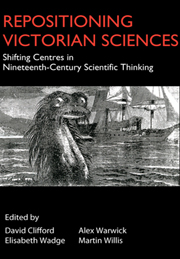Book contents
- Frontmatter
- Contents
- Notes on Contributors
- 1 Margins and Centres
- SECTION I Shifted Centres
- 2 ‘Speakers Concerning the Earth’: Ruskin's Geology After 1860
- 3 Swimming at the Edges of Scientific Respectability: Sea Serpents in the Victorian Era
- 4 ‘The Drugs, The Blister and the Lancet are all Laid Aside’: Hydropathy and Medical Orthodoxy in Scotland, 1840–1900
- 5 Anna Kingsford: Scientist and Sorceress
- 6 A Science for One or a Science for All? Physiognomy, Self-Help, and the Practical Benefits of Science
- SECTION II Contested Knowledges
- SECTION III Entering The Modern
- Notes
- Select Bibliography
6 - A Science for One or a Science for All? Physiognomy, Self-Help, and the Practical Benefits of Science
from SECTION I - Shifted Centres
Published online by Cambridge University Press: 05 March 2012
- Frontmatter
- Contents
- Notes on Contributors
- 1 Margins and Centres
- SECTION I Shifted Centres
- 2 ‘Speakers Concerning the Earth’: Ruskin's Geology After 1860
- 3 Swimming at the Edges of Scientific Respectability: Sea Serpents in the Victorian Era
- 4 ‘The Drugs, The Blister and the Lancet are all Laid Aside’: Hydropathy and Medical Orthodoxy in Scotland, 1840–1900
- 5 Anna Kingsford: Scientist and Sorceress
- 6 A Science for One or a Science for All? Physiognomy, Self-Help, and the Practical Benefits of Science
- SECTION II Contested Knowledges
- SECTION III Entering The Modern
- Notes
- Select Bibliography
Summary
Perhaps more than any other historical period, the Victorian age emphasized the link between the management of morals and the social health of the nation. If an individual could exercise control over his or her own behaviour, regulating undesirable propensities and developing positive faculties, then society would function according to the organic principles of steady growth, gradual development and eventual transformation. The tradition of self-help books promoted this idea of governance in that they offered practical guides to the working and middle classes about almost any aspect of human life, from conduct to cooking. Samuel Smiles's Self-Help (1859) was a hugely influential early example of a genre of writing that has again become popular for its advocacy of the benefits of individual action as a means towards self-knowledge and personal development. Then, as now, this idea of self-help was underpinned by hard work and perseverance, both virtues that had currency in all classes of society.
It might seem curious to group practical guides to the mind with cookery books, but a defining characteristic of the Victorian period was its preoccupation with seeing the hidden patterns that lay beneath the surface of things. Of special interest were explorations of the workings of the human mind because they provided insights into individuality and autonomy, and in particular the significance of will. The practices of physiognomy and phrenology fed this interest in mind and body, providing readings of external (physical) appearance that illuminated internal (mental) form.
- Type
- Chapter
- Information
- Repositioning Victorian SciencesShifting Centres in Nineteenth-Century Thinking, pp. 71 - 82Publisher: Anthem PressPrint publication year: 2006



